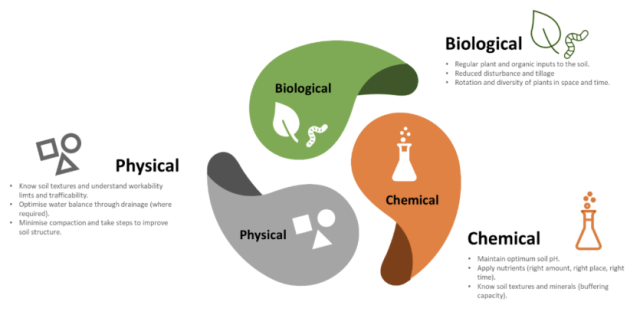
Soil health in UK farming
A technical article introducing principles of soil health measurement, management and support available to improve soil health on farm
Soils provide the foundation of agriculture and food production systems with estimates suggesting that 95% of global food production is directly or indirectly produced on our soils.i
In the context of farming, soil health broadly refers to the continued capacity of soil to function as an ecosystem that sustains plants, animals and humans.
Healthy soils provide ecosystem services and functions with greater longevity, for instance they demonstrate greater resilience against erosion, flooding and climate change. In addition, healthy soils offer a range of direct benefits.
These include:
- Improved nutrient availability – healthy soils provide essential plant nutrients, which reduces the need for artificial nutrient additions overtime., reducing costs.
- Enhanced resilience to extreme weather – higher levels of soil organic matter increase the ability of soils to hold moisture and increase infiltration rate, which protects land from extreme weather events such as flooding or droughts.
- Sustainable crop production – healthy soils support robust crop production, contributing to a sustainable future for farming.
- Environmental regulation – soil health contributes to the regulation of air and water quality as well as climate and supports biodiversity and carbon sequestration.
Threats to soil health and consequences of poor soil management
A 2019 Environmental Agency report assessing soils in England and Wales found that almost 4 million hectares of soil are at risk of compaction and over 2 million hectares of soil are at risk of erosion. Between 40 - 60% of soil organic carbon content was lost as a result of intensive agricultural management practices. In a financial context, soil degradation was calculated to have an annual cost of £1.2 billion.ii
Threats to soil health include:
Loss of soil organic carbon
- Loss of soil organic matter diminishes soil structure stability, nutrient retention capacity and microbial activity.
- This leads to reduced soil fertility, diminished soil carbon storage capacity and implications for climate change mitigation
Soil compaction
- Soil compaction resulting from heavy machinery use can restrict root growth, impair water infiltration, increase runoff leading to flood risk and reduced soil productivity.
Soil erosion
- Soil erosion leads to loss of topsoil, lower crop yields, increased flood risk and water quality implications (e.g. sedimentation and pollution).
Soil biodiversity loss
- Soil biodiversity loss includes the destruction of habitats for earthworms and microorganisms.
- Biodiversity loss weakens the resilience of ecosystems to changing environmental conditions, hinders natural pest control mechanisms and nutrient cycling processes.This ultimately posing a threat to the long-term sustainability of agricultural systems.
Sustainable management practices, conservation strategies and policy interventions can safeguard soil health and ensure the longevity of soils for future generations.
Principles of soil health management
As the global population rises and with it the increasing demands on food productions systems, maintaining healthy and productive soils is vital. Soil health requires a balance between biological, physical and chemical properties of soils in order to provide good structure, water retention and nutrient availability to crops. Whilst soil management practices vary significantly, the Agriculture and Horticulture Development Board (AHDB) have outlined some general principles, summarised below in Figure 1, that influence soil health 3 and underpin all farming systems. By following these principles, farmers will achieve greater carbon sequestration, increased water infiltrations, improved wildlife and pollinator habitat, all whilst optimising yields and profits.

Biological principles
It is important to understand the influence and importance of soil management practices on maintaining diverse and active biological soil communities.
Organic matter is a key biological component, organic matter inputs will provide a direct source of energy/food for soil organisms.
Tillage can influence a range of properties including root activity, soil surface coverage and the distribution of organic matter throughout the soil. Habitat stabilisation, as a result of reduced tillage, is beneficial to a range of soil organisms and can result in increased soil biological activity.
Rotations should be designed to increase plant diversity to promote species richness of the soil biota.
Soil health measurement
Many soil properties such as parent material and texture are inherent to a soil, whilst others may be influenced through appropriate management practices. Characterising and understanding the implications of these properties can influence the selection of suitable soil health management actions. There are a wide range of parameters which may be used as indicators of the health of agricultural soils. These include:
- Common indicators – pH, routine nutrients, bulk density and penetrometer resistance.
- Less common indictors – visual evaluation of soil structure (VESS), soil organic matter/loss on ignition, respiration and earthworms.
- Newer indicators – total nitrogen, microbial biomass carbon, potentially mineralisation nitrogen, DNA measures, nematodes and microarthropods.
AHDB has proposed a soil health scorecard to provide a framework against which soil health can be monitored on a rotational basisiv. These scorecard indicators align well with the sustainable farming initiative (SFI) and include:
- Soil structure – using VESS (visual evaluation of soil structure)
- Soil pH – a measure of the acidity or alkalinity of the soil.
- Extractable nutrients – the measure of major nutrients essential to plant growth.
- Earthworm count – a simple measure of biological health.
- Soil organic matter – a measure of the amount of carbon stored in a soil.
To monitor improvements or changes to soil health, it is important to establish a set of baseline measurements. For meaningful comparison, the methods and types of measurements taken on each monitoring occasion should be consistent.
i FAO. Healthy soils are the basis for healthy food production. Food and Agriculture Organisation of the United Nations: Rome, Italy, 2015.
ii House of Commons Committee report on Soil Health: https://publications.parliament.uk/pa/cm5804/cmselect/cmenvfru/245/report.html# iii AHDB. Principles to improve soil health. Agriculture and Horticulture Development Board iv AHDB. The soil health scorecard. Agriculture and Horticulture Development Board, 2022. https://ahdb.org.uk/knowledge-library/the-soil-health-scorecard v UK Gov. Guidance: SFI actions for soils. 2023. https://www.gov.uk/guidance/sfi-actions-for-soils